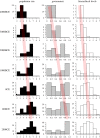The cultural evolution and ecology of institutions
- PMID: 33993755
- PMCID: PMC8126459
- DOI: 10.1098/rstb.2020.0047
The cultural evolution and ecology of institutions
Abstract
Human societies are structured by what we refer to as 'institutions', which are socially created and culturally inherited proscriptions on behaviour that define roles and set expectations about social interactions. The study of institutions in several social science fields has provided many important insights that have not been fully appreciated in the evolutionary human sciences. However, such research has often lacked a shared understanding of general processes of change that shape institutional diversity across space and time. We argue that evolutionary theory can provide a useful framework for synthesizing information from different disciplines to address issues such as how and why institutions change over time, how institutional rules co-evolve with other culturally inherited traits, and the role that ecological factors might play in shaping institutional diversity. We argue that we can gain important insights by applying cultural evolutionary thinking to the study of institutions, but that we also need to expand and adapt our approaches to better handle the ways that institutions work, and how they might change over time. In this paper, we illustrate our approach by describing macro-scale empirical comparative analyses that demonstrate how evolutionary theory can be used to generate and test hypotheses about the processes that have shaped some of the major patterns we see in institutional diversity over time and across the world today. We then go on to discuss how we might usefully develop micro-scale models of institutional change by adapting concepts from game theory and agent-based modelling. We end by considering current challenges and areas for future research, and the potential implications for other areas of study and real-world applications. This article is part of the theme issue 'Foundations of cultural evolution'.
Keywords: barrier effects; cultural evolution; driven trend; institutions; political complexity.
Figures



Similar articles
-
The uses and abuses of tree thinking in cultural evolution.Philos Trans R Soc Lond B Biol Sci. 2021 Jul 5;376(1828):20200056. doi: 10.1098/rstb.2020.0056. Epub 2021 May 17. Philos Trans R Soc Lond B Biol Sci. 2021. PMID: 33993767 Free PMC article. Review.
-
Evolutionary accounts of human behavioural diversity.Philos Trans R Soc Lond B Biol Sci. 2011 Feb 12;366(1563):313-24. doi: 10.1098/rstb.2010.0267. Philos Trans R Soc Lond B Biol Sci. 2011. PMID: 21199836 Free PMC article.
-
A dynamic over games drives selfish agents to win-win outcomes.Proc Biol Sci. 2020 Dec 23;287(1941):20202630. doi: 10.1098/rspb.2020.2630. Epub 2020 Dec 16. Proc Biol Sci. 2020. PMID: 33323083 Free PMC article.
-
Mode and tempo in the evolution of socio-political organization: reconciling 'Darwinian' and 'Spencerian' evolutionary approaches in anthropology.Philos Trans R Soc Lond B Biol Sci. 2011 Apr 12;366(1567):1108-17. doi: 10.1098/rstb.2010.0318. Philos Trans R Soc Lond B Biol Sci. 2011. PMID: 21357233 Free PMC article.
-
Cultural Change: The How and the Why.Perspect Psychol Sci. 2017 Nov;12(6):956-972. doi: 10.1177/1745691617699971. Epub 2017 Sep 15. Perspect Psychol Sci. 2017. PMID: 28915361 Review.
Cited by
-
Integrating evolutionary theory and social-ecological systems research to address the sustainability challenges of the Anthropocene.Philos Trans R Soc Lond B Biol Sci. 2024 Jan;379(1893):20220262. doi: 10.1098/rstb.2022.0262. Epub 2023 Nov 13. Philos Trans R Soc Lond B Biol Sci. 2024. PMID: 37952618 Free PMC article. Review.
-
Modelling the role of environmental circumscription in the evolution of inequality.Philos Trans R Soc Lond B Biol Sci. 2023 Aug 14;378(1883):20220291. doi: 10.1098/rstb.2022.0291. Epub 2023 Jun 26. Philos Trans R Soc Lond B Biol Sci. 2023. PMID: 37381863 Free PMC article.
-
Foundations of cultural evolution.Philos Trans R Soc Lond B Biol Sci. 2021 Jul 5;376(1828):20200041. doi: 10.1098/rstb.2020.0041. Epub 2021 May 17. Philos Trans R Soc Lond B Biol Sci. 2021. PMID: 33993761 Free PMC article. No abstract available.
-
Playing the political game: the coevolution of institutions with group size and political inequality.Philos Trans R Soc Lond B Biol Sci. 2023 Aug 14;378(1883):20220303. doi: 10.1098/rstb.2022.0303. Epub 2023 Jun 26. Philos Trans R Soc Lond B Biol Sci. 2023. PMID: 37381856 Free PMC article.
-
The social leverage effect: Institutions transform weak reputation effects into strong incentives for cooperation.Proc Natl Acad Sci U S A. 2024 Dec 17;121(51):e2408802121. doi: 10.1073/pnas.2408802121. Epub 2024 Dec 13. Proc Natl Acad Sci U S A. 2024. PMID: 39671186 Free PMC article.
References
-
- Currie TE, Turchin P, Bednar J, Richerson PJ, Schwesinger G, Steinmo S, Wacziarg R, Wallis J. 2016. The evolution of institutions and organizations, In Complexity and evolution: a new synthesis for economics (eds Wilson DS, Kirkman A, Beinhoffer E). Cambridge, MA: MIT Press, Ernst Strüngmann Forum.
-
- Richerson P, Henrich J. 2012. Tribal social instincts and the cultural evolution of institutions to solve collective action problems. Cliodynamics 3, 38-80. (10.21237/c7clio3112453) - DOI
-
- Acemoglu D, Robinson JA. 2012. Why nations fail: the origins of power, proseprity, and poverty. New York, NY: Crown Publishing Group.
-
- North DC. 1990. Institutions, institutional change and economic performance. Cambridge, UK: Cambridge University Press.
Publication types
MeSH terms
Associated data
LinkOut - more resources
Full Text Sources
Other Literature Sources

